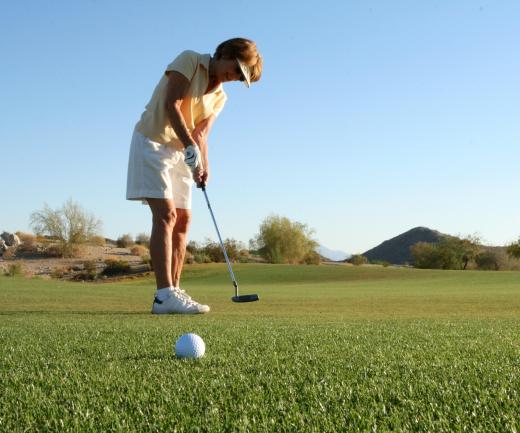A putting green refers to a section of green turf on a golf course with a hole marked by a flag. The golfer tries to get the golf ball into the hole by using a golf club called a putter. Even though the golf ball can be quite close to the hole during putting, these shots can be difficult. When not on the golf course, golf enthusiasts often practice on either a portable putting green in their home or office or on a putting green they have installed in their backyard.
Do-it-yourself putting green kits are available or a company that specializes in creating putting greens that fit in with the existing landscaping can be hired. Artificial turf that is made to resist fading and damage from the weather is often used for putting greens, but real grass can be used instead. A backyard putting green can be made to be as close to the kind on a commercial golf course as possible. This can be a great source of pleasure to the homeowner as he or she can not only practice putting, but entertain fellow golf enthusiasts as well.

Artificial grass putting greens are favored by many as they don't require mowing or fertilizing. Small indoor putting greens with artificial grass are great for practice on rainy or snowy days. They are used in homes such as in a basement, den or family room as well as in some offices. Real grass putting greens can be great for those who like to garden because they can be a lot of work. Many golfers say that real grass is worth the work because it is best for a true ball roll that artificial greens just can't match.

Commercial golf courses may have either real or artificial grass putting greens. In hot climates, real grass can be very difficult to keep green. Bermuda grass is a real grass that is often considered the best for holding up in warm temperatures. Bentgrass is a real grass that is typically used in areas with milder climates.
Indoor putting greens with artificial grass are increasingly popular for golf enthusiasts, providing a convenient practice solution on rainy or snowy days. The low-maintenance artificial grass requires no mowing or fertilizing, making it a top choice for consistent performance.
For those who may not have the luxury of a backyard putting green, investing in one of the best putting mats can be an excellent alternative. These mats are designed to mimic the conditions of a real green, offering a practical and convenient way to practice your putting skills indoors. Whether you're a seasoned golfer or a beginner, a high-quality putting mat can provide the consistent surface you need to refine your technique and build confidence.
By incorporating regular practice on the best putting green at home, golfers can develop muscle memory, refine their skills, and build the confidence needed to excel on the course. This dynamic combination of on-course experience and dedicated practice on the best putting green is key to maximizing one's golfing potential and achieving consistently better performance.
A well-maintained putting green is essential for golfers looking to improve their short game. Whether practicing at a local course or in the comfort of one's own home with a golf putting mat, the quality of the surface can significantly impact putting skills. By understanding the characteristics and maintenance of a putting green, players can ensure a more consistent and enjoyable golfing experience. Remember, the path to lowering your handicap often starts with mastering the art of the putt, and the right surface can make all the difference.
